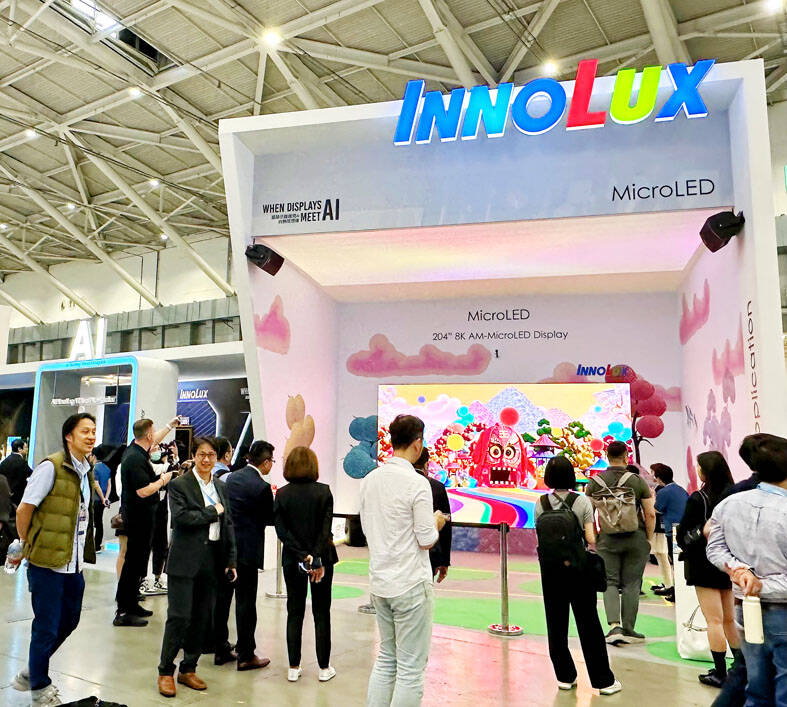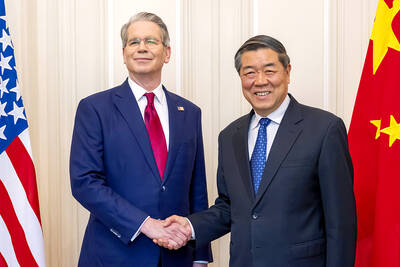Flat-panel display maker Innolux Corp (群創) yesterday said it has made breakthroughs tapping into the semiconductor industry and began shipping fan-out-panel-level-packaging (FOPLP) products to its customers last quarter, which it said would generate a new revenue stream of NT$100 million (US$3.33 million) over the next three quarters.
The shipments came as planned after being rescheduled a couple times. Innolux has recalibrated its investment to better-margin chip packaging technologies, leveraging its flat-panel manufacturing technology and equipment.
The chips delivered to customers are made on entry-level FOPLP technology, called Chip-first, Innolux chairman and chief executive officer Jim Hung (洪進揚) told an online investors’ conference yesterday.

Photo: Chen Mei-ying, Taipei Times
The Chip-first technology is suitable to package radio frequency, power management and automotive radar chips, Innolux said.
The company said it is collaborating with potential customers to develop two more sophisticated panel-level packaging technologies, Chip-last and TGA, for consumer chips, and chips used in artificial intelligence and high-performance-computing applications.
Innolux posted a loss of NT$761 million in the second quarter of the year, snapping four consecutive profitable quarters. That compared with a quarterly profit of NT$962 million in the first quarter of this year and NT$1.13 billion in the second quarter last year.
Innolux attributed the loss to foreign-exchange losses of NT$2.9 billion and a slowdown in front-loading demand.
Gross margin improved to 8.4 percent in the second quarter from 7.6 percent in the first quarter, indicating that the company’s strategy of boosting its non-display business started to bear fruit, the company said.
Non-commodity business made up 44 percent of last quarter’s overall revenue, up from 40 percent in the first quarter, Hung said.
Non-commodity delivers a better margin than the commodity display business, he said.
Looking ahead, Innolux said customers became more conservative about placing new orders for its products across the board due to tariff-related uncertainty and fading front-loading demand.
Shipments of non-display products and commercial displays are to drop by a low-single-digit percentage this quarter from last quarter, while regular displays are to see a mid-single-digit percentage decline quarter-on-quarter.
As for the impact of the US tariffs, Innolux said it is collaborating with customers’ requests to reroute their shipments or to reschedule their deliveries.
The company plans to allocate NT$15 billion to NT$16 billion for capital expenditure this year.

Jensen Huang (黃仁勳), founder and CEO of US-based artificial intelligence chip designer Nvidia Corp and Taiwan Semiconductor Manufacturing Co (TSMC, 台積電) on Friday celebrated the first Nvidia Blackwell wafer produced on US soil. Huang visited TSMC’s advanced wafer fab in the US state of Arizona and joined the Taiwanese chipmaker’s executives to witness the efforts to “build the infrastructure that powers the world’s AI factories, right here in America,” Nvidia said in a statement. At the event, Huang joined Y.L. Wang (王英郎), vice president of operations at TSMC, in signing their names on the Blackwell wafer to

AI BOOST: Although Taiwan’s reliance on Chinese rare earth elements is limited, it could face indirect impacts from supply issues and price volatility, an economist said DBS Bank Ltd (星展銀行) has sharply raised its forecast for Taiwan’s economic growth this year to 5.6 percent, citing stronger-than-expected exports and investment linked to artificial intelligence (AI), as it said that the current momentum could peak soon. The acceleration of the global AI race has fueled a surge in Taiwan’s AI-related capital spending and exports of information and communications technology (ICT) products, which have been key drivers of growth this year. “We have revised our GDP forecast for Taiwan upward to 5.6 percent from 4 percent, an upgrade that mainly reflects stronger-than-expected AI-related exports and investment in the third

RARE EARTHS: The call between the US Treasury Secretary and his Chinese counterpart came as Washington sought to rally G7 partners in response to China’s export controls China and the US on Saturday agreed to conduct another round of trade negotiations in the coming week, as the world’s two biggest economies seek to avoid another damaging tit-for-tat tariff battle. Beijing last week announced sweeping controls on the critical rare earths industry, prompting US President Donald Trump to threaten 100 percent tariffs on imports from China in retaliation. Trump had also threatened to cancel his expected meeting with Chinese President Xi Jinping (習近平) in South Korea later this month on the sidelines of the APEC summit. In the latest indication of efforts to resolve their dispute, Chinese state media reported that

CHINESE EXPORT CURBS: A dispute between China and the Netherlands could halt chip supply, affecting vehicle production, US and European auto associations said Groups representing major automakers late on Thursday warned that a chip disruption stemming from a dispute between China and the Dutch government could quickly affect US auto production. Automakers and their suppliers received notice from chipmaker Nexperia (安世半導體) last week that it could no longer guarantee delivery of its chips, the European Automobile Manufacturers Association said, adding that manufacturing could be significantly disrupted. In the US, the Alliance for Automotive Innovation, which represents General Motors, Toyota, Ford, Volkswagen, Hyundai and nearly all other major automakers, urged a quick resolution. “If the shipment of automotive chips doesn’t resume — quickly — it’s going to